.gif)
James Harper (publisher)
Encyclopedia
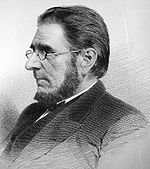
United States
The United States of America is a federal constitutional republic comprising fifty states and a federal district...
publisher and politician in the early-to-mid 19th century. James was the eldest of four sons born to Joseph Henry Harper, (1750-1838) , a farmer, carpenter, and storekeeper, and Elizabeth Kolyer, daughter of Jacobus Kolyer (1749-1819) and Jane Miller.
Childhood and starting in business
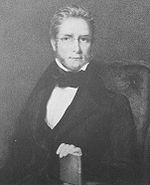
New York
New York is a state in the Northeastern region of the United States. It is the nation's third most populous state. New York is bordered by New Jersey and Pennsylvania to the south, and by Connecticut, Massachusetts and Vermont to the east...
. As a boy, he read The Autobiography of Benjamin Franklin
The Autobiography of Benjamin Franklin
The Autobiography of Benjamin Franklin is the traditional name for the unfinished record of his own life written by Benjamin Franklin from 1771 to 1790; however, Franklin himself appears to have called the work his Memoirs...
, and decided that he would like to pursue a career as a printer because of Franklin's success in the field. An apprenticeship was subsequently arranged with a family friend, Abraham Paul, who was a partner in the New York printshop of Paul & Thomas. James' younger brother John (22 January 1797 – 22 April 1875) began his printing apprenticeship at another printer in the city within two years. In 1817 the two brothers had learned what they could of the profession and felt that they were ready to try their hand at running their own printing business. In 1817, the brothers founded J. & J. Harper
Harper & Brothers
Harper is an American publishing house, the flagship imprint of global publisher HarperCollins.-History:James Harper and his brother John, printers by training, started their book publishing business J. & J. Harper in 1817. Their two brothers, Joseph Wesley Harper and Fletcher Harper, joined them...
in New York at the corner of Dover and Front streets; James was nearly 22 years old and John was 20. The business was supported by a loan from their father to purchase two Rampage printing presses, some typesetting stock, and simple binding equipment.
In 1817 Paul received an order from the prominent New York bookseller Evert Duyckinck for 2,000 copies of an English translation of Seneca
Seneca the Younger
Lucius Annaeus Seneca was a Roman Stoic philosopher, statesman, dramatist, and in one work humorist, of the Silver Age of Latin literature. He was tutor and later advisor to emperor Nero...
's Morals ("Seneca's morals by way of abstract", translated by Roger L'Estrange
Roger L'Estrange
Sir Roger L'Estrange was an English pamphleteer and author, and staunch defender of royalist claims. L'Estrange was involved in political controversy throughout his life...
and first published in England
England
England is a country that is part of the United Kingdom. It shares land borders with Scotland to the north and Wales to the west; the Irish Sea is to the north west, the Celtic Sea to the south west, with the North Sea to the east and the English Channel to the south separating it from continental...
in 1678.) Paul gave the order to his young apprentices, James and John, who did the printing, working with their younger brothers Joseph Wesley (25 December 1801 – 14 February 1870) and Fletcher (31 January 1806 – 29 May 1877) who aided in setting type, and issued it under the imprint J. & J. Harper. This book was followed in 1818 with an edition of John Locke
John Locke
John Locke FRS , widely known as the Father of Liberalism, was an English philosopher and physician regarded as one of the most influential of Enlightenment thinkers. Considered one of the first of the British empiricists, following the tradition of Francis Bacon, he is equally important to social...
's An Essay Concerning Human Understanding
An Essay Concerning Human Understanding
First appearing in 1690 with the printed title An Essay Concerning Humane Understanding, An Essay Concerning Human Understanding by John Locke concerns the foundation of human knowledge and understanding. He describes the mind at birth as a blank slate filled later through experience...
(1818), which they issued under the J. & J. Harper imprint as publisher rather than merely printer.
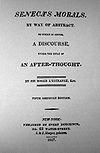
- Harper was a big fellow with a prejudice against liquor, but with such a jovial nature that he became known among the hard drinking printers as "the teetotaler who was never sober". (Glyndon G. van Deusen, 1944)
Publishing
With his brother John, James founded the printer J. & J. Harper in 1817. The name was changed to Harper & BrothersHarper & Brothers
Harper is an American publishing house, the flagship imprint of global publisher HarperCollins.-History:James Harper and his brother John, printers by training, started their book publishing business J. & J. Harper in 1817. Their two brothers, Joseph Wesley Harper and Fletcher Harper, joined them...
in 1825 when the two other brothers, Wesley & Fletcher Harper
Fletcher Harper
Fletcher Harper was an American publisher in the early-to-mid 19th century. Fletcher was the youngest of four sons born to Joseph Henry Harper, , a farmer, carpenter, and storekeeper, and Elizabeth Kollyer, a Dutch burgher's daughter...
, joined their brothers. With the name change the company also broadened their printing business to also include publishing services.
First big success was Maria Monk
Maria Monk
Maria Monk was a Canadian woman who claimed to have been a nun who had been sexually exploited in her convent...
's Awful Disclosures (1836). Often described as the "Uncle Tom's Cabin
Uncle Tom's Cabin
Uncle Tom's Cabin; or, Life Among the Lowly is an anti-slavery novel by American author Harriet Beecher Stowe. Published in 1852, the novel "helped lay the groundwork for the Civil War", according to Will Kaufman....
of nativism
Nativism (politics)
Nativism favors the interests of certain established inhabitants of an area or nation as compared to claims of newcomers or immigrants. It may also include the re-establishment or perpetuation of such individuals or their culture....
", the book went on to sell 300,000 copies for Harper & Brothers. It was later disclosed that Theodore Dwight
Theodore Dwight (author)
-Life:Theodore Dwight was born March 3, 1796 in Hartford, Connecticut.His father was Theodore Dwight of the New England Dwight family. His mother was Abigail Alsop , the sister of Richard Alsop ....
was the actual author of the work, though he claimed it was dictated. The book ostensibly told the story of a Canadian woman who claimed to have been a nun who had been sexually exploited in her convent. The work was published during a time of extreme anti-Catholicism
Anti-Catholicism
Anti-Catholicism is a generic term for discrimination, hostility or prejudice directed against Catholicism, and especially against the Catholic Church, its clergy or its adherents...
in the United States, and was used by politicians and anti-Catholic activists to seed discontent and incite riots. In the words of the historian Ray Allen Billington, it became "the most influential single work of anti-Catholic propaganda in America's history".
Within eight years of the publication of Awful Disclosures James Harper was elected mayor of New York, running on a Know-Nothing, Nativist platform of anti-Catholicism and anti-immigration. This time in New York City's history can be seen in Luc Sante
Luc Sante
-Early life:Born in Verviers, Belgium, Sante emigrated to the United States in the early 1960s. He attended school in New York City, first at Regis High School in Manhattan and then at Columbia University.-Writing:...
's 1991 book Low Life, Herbert Asbury
Herbert Asbury
Herbert Asbury was an American journalist and writer who is best known for his true crime books detailing crime during the 19th and early 20th century such as Gem of the Prairie, Barbary Coast: An Informal History of the San Francisco Underworld and The Gangs of New York...
's 1927 highly dramatized book The Gangs of New York, and Martin Scorsese
Martin Scorsese
Martin Charles Scorsese is an American film director, screenwriter, producer, actor, and film historian. In 1990 he founded The Film Foundation, a nonprofit organization dedicated to film preservation, and in 2007 he founded the World Cinema Foundation...
's 2002 movie of the same name. Ms. Monk's book had a brief revival in the 1960s during John F. Kennedy
John F. Kennedy
John Fitzgerald "Jack" Kennedy , often referred to by his initials JFK, was the 35th President of the United States, serving from 1961 until his assassination in 1963....
's run for the Presidency of the United States.
Harper & Brothers became Harper & Row in 1962 when the firm merged with Row, Petersen & Co. Following News Corporation
News Corporation
News Corporation or News Corp. is an American multinational media conglomerate. It is the world's second-largest media conglomerate as of 2011 in terms of revenue, and the world's third largest in entertainment as of 2009, although the BBC remains the world's largest broadcaster...
's acquisition of Harper & Row in 1987, the company was merged with William Collins
William Collins (publisher)
William Collins was a Scottish schoolmaster and publisher.Collins was born near Glasgow in 1789. In 1819 he set up a publishing business, initially selling religious books. He produced the first Collins dictionary in 1824, when he also obtained a licence to publish the Bible...
publishers in 1990, resulting in its current name, HarperCollins
HarperCollins
HarperCollins is a publishing company owned by News Corporation. It is the combination of the publishers William Collins, Sons and Co Ltd, a British company, and Harper & Row, an American company, itself the result of an earlier merger of Harper & Brothers and Row, Peterson & Company. The worldwide...
. HarperCollins had sales of US$1,162 million in 2004 and employs over 3,000 people worldwide.
Politics
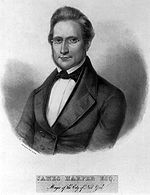
American Republican Party
The American Republican Party was a minor nativist political organization that was launched in New York in June 1843, largely as a protest against immigrant voters and officeholders. In 1844, it carried municipal elections in New York City and Philadelphia and expanded so rapidly that by July,...
mayor of New York for one-year term, defeating Locofoco Party candidate Jonathan I. Coddington and Whig
Whig Party (United States)
The Whig Party was a political party of the United States during the era of Jacksonian democracy. Considered integral to the Second Party System and operating from the early 1830s to the mid-1850s, the party was formed in opposition to the policies of President Andrew Jackson and his Democratic...
Morris Franklin. James won the election by 4,316 votes.
He reformed the city police force and established the first municipal police force in 1844, based on planning undertaken earlier by Peter Cooper
Peter Cooper
Peter Cooper was an American industrialist, inventor, philanthropist, and candidate for President of the United States...
. In-fighting between the city alderman delayed full implementation of the reform plan, and Harper was only able to select 200 men for the force before he was ousted by voters in April 1845. He outfitted his "Harper's Police" in blue uniforms, which they felt made them targets of violence, and they lobbied successfully to wear street clothes. His successor William Havemeyer continued to reform the police force and was successful in expanding the force to 800 and beginning the establishment of station houses.
Harper banished free-roaming pigs from the streets of New York, and began work on establishing a citywide sanitation system. He was subsequently put forward for the governorship of the state; but he preferred to conduct the business of his firm rather than enter public life.
Residences
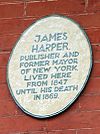
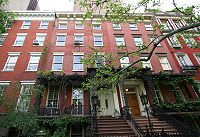
Gramercy Park
Gramercy Park is a small, fenced-in private park in the borough of Manhattan in New York City, United States. The park is at the core of both the neighborhood referred to as either Gramercy or Gramercy Park and the Gramercy Park Historic District...
West from 1847 until his death in 1869. Greek Revival, architect Alexander Jackson Davis
Alexander Jackson Davis
Alexander Jackson Davis, or A. J. Davis , was one of the most successful and influential American architects of his generation, in particular his association with the Gothic Revival style....
.
NYC legacy

Green-Wood Cemetery
Green-Wood Cemetery was founded in 1838 as a rural cemetery in Brooklyn, Kings County , New York. It was granted National Historic Landmark status in 2006 by the U.S. Department of the Interior.-History:...
, Brooklyn
Brooklyn
Brooklyn is the most populous of New York City's five boroughs, with nearly 2.6 million residents, and the second-largest in area. Since 1896, Brooklyn has had the same boundaries as Kings County, which is now the most populous county in New York State and the second-most densely populated...
, N.Y.
Served as a Vassar
Vassar College
Vassar College is a private, coeducational liberal arts college in the town of Poughkeepsie, New York, in the United States. The Vassar campus comprises over and more than 100 buildings, including four National Historic Landmarks, ranging in style from Collegiate Gothic to International,...
trustee until his death in 1869.
Harper Avenue in the Bronx, New York is named in his honor. Harper Avenue is located two blocks from the terminus of the number 5 line in the New York City subway system--the Dyre Avenue stop.

